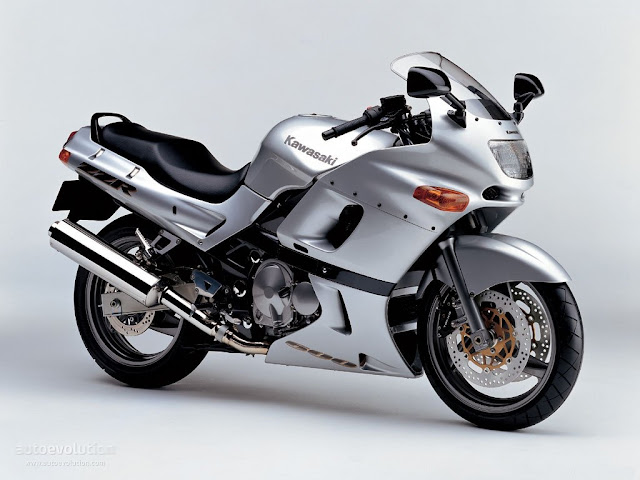Kawasaki ZZ-R1100
Sheer power and speed were the original ZZ-R's main claims to fame, hut for a big machine the Kawasaki went round corners in style.
In 1993 the ZZ-R was revised with a taller screen, larger fuel tank and new frame. Its high-speed ability remained - following the press launch in Arizona, three journalists were jailed for speeding.
When Kawasaki's engineers set out to | create the world's fastest hike in the late HHI 1980s, they had the advantage of many years' experience in designing powerful four- cylinder engines - plus one very significant technical innovation. The result was a new superbike, the ZZ-R 1100, whose liquid-cooled, four-cylinder engine, boosted by a novel ‘ram-air’ system, produced 145bhp and sent the bike hurtling to 175mph (282km/h).
That level of performance put the Kawasaki far ahead of all opposition when it was launched in 1990. and it remained the world's fastest bike for the next five years. There was much more to the ZZ-R (known as the ZX-11 in the States) than its engine, for it was a refined and efficient sports- tourer. But there was no escaping the fact that the Kawasaki’s trump card was its phenomenal straight-line speed.
Forced induction, to give the ram-air system its conventional name, was derived from Formula One racecar technology. It was a sealed system that ducted air from a slot in the fairing’s nose, directly to the unusually large airbox. The faster the Kawasaki went, the more cool air was forced through its carburettors and into the engine.
Intake system apart, the ZZ-R had much in common with the ZX-10, its predecessor as Kawasaki's flagship. Bulbous bodywork held faired-in indicators; the chassis was based on a rigid twin-spar aluminium frame. The new engine shared the ZX-lO’s liquid-cooled, 16-valve layout but had a 2mm larger bore, increasing capacity to 1052cc. Other changes included larger valves, newcamshafts, lightened pistons, a new curved radiator and a more efficient twin-silencer exhaust system.
When the throttle was wound open above 5000rpm, smooth power sent the bike rocketing forward. It kicked into hyperdrive at around 7000rpm and kept the rider's arms and reflexes stretched as it snarled to the 11 .OOOrpm redline through the efficient six-speed gearbox. In contrast the response below 4000rpm was weak, though ar. improvement over that of the ZX-IO.
High speed composure and stability were remarkable. Even with the scenery and road flashing past at over I50mph (24lkm h . the protection of its fairing and the quality of its chassis give the impression of travelling much less rapidly. American magazine Cycle managed a genuine I75mph (282km hi from their full-power ZZ-Rl 100. Bikes in manv European countries left the dealerships slightly slow er due to politically enforced power limits. In most cases these were implemented by carburettor restrictors that were easy to remove.
Although the ZZ-R's frame resembled that of the ZX-IO it was slightly thicker and stiffer. as well as 10mm (0.4in) shorter in the wheelbase. Steering geometry was steeper and the cycle pans w ere also new. Fork legs were enlarged to 43mm in diameter and, like the single rear shock, were adjustable for rebound damping as well as spring preload.
The ZZ-R was a long, roomy hike that was far too heavy to be mistaken for a sports bike, but it handled well. Much of the mass seemed to drop aw a\ on the mov e, and the stiff chassis and firm »u>pension gave the Kawasaki a well-balanced feel. It w.tv -stable even at high speed, and its triple disc brake >ystem was powerful.
This was just as well, because if any bike needed good brakes it was the ZZ-R. The bike’s comfort and practicality contributed to its reputation as a fine all-rounder. Numerous neat details included a comfortable seat, clear mirrors, bungee hooks and a much-needed grab-rail. But all those things were insignificant when compared with the ZZ-Rl 100’s greatest asset: the magnificent, ram-air assisted motor that generated its all-conquering speed.
The distinctive ZZ-R shape would remain essentially unchanged through several revisions and more than a decade of development. Key to the 16-valve motor’s performance was its ram- air induction system, fed via a slot in the fairing nose. But despite its deserved reputation for speed, the ZZ-R was always more of an all-rounder than a pure performance machine.
Specification Kawasaki ZZ-R1100 (ZX-11) (1990)
- Engine Liquid-cooled dohc 16-valve four
- Capacity 1052cc (76 x 58mm)
- Maximum power 145bhp @ 9500rpm
- Transmission Six-speed, chain final drive
- Frame Aluminium twin spar
- Suspension Telescopic front; single shock rear
- Brakes Twin discs front; disc rear
- Weight 502lb (228kg)
- Top speed 175mph (282km/h)

















0 comments: